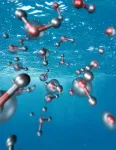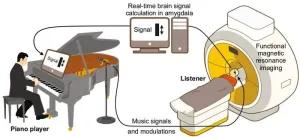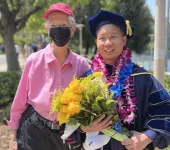(Press-News.org) To become carbon neutral by 2060, as mandated by President Xi Jinping, China will have to build eight to 10 times more wind and solar power installations than existed in 2022. Reaching carbon neutrality will also require major construction of transmission lines.
China land use policies will also have to be more coordinated and focused on a nation-wide scale rather than be left to ad hoc decisions by local governments. That’s because 80% of solar power and 55% of wind power will have to be built within 100 miles of major population centers.
These are the conclusions of a new study from researchers at Tsinghua University in Beijing and at the University of California San Diego. The team publishes their findings in the Feb. 26, 2024 issue of the Proceedings of the National Academy of Sciences.
“We know China has a very ambitious pathway to achieve carbon neutrality. We wanted to find out exactly what that entails,” said Michael Davidson, a senior author of that study and a professor at the School of Global Policy and Strategy and the Jacobs School of Engineering at UC San Diego.
One of the goals of the study is to inform renewable energy planning and policy in China. But the information is also crucial because China is currently the world’s biggest greenhouse gas emitter. So the country’s policies impact the global climate change picture and the planet’s future. Other countries can also learn from China’s successes and failures.
The study is based on an ambitious model that simulated China’s carbon neutral power grid in 2060 and what it would take to get there. The model looks at power generation resources and transmission line installations at an unprecedented resolution, considering parcels of land as small as 20 to 30 square kilometers. The model can also be applied to other countries.
As the researchers built and ran the model, the importance of land use became clearer. For example, China’s east, near the coast, will run out of land that can be used for renewable energy plants. As a result, any solar installations in that area need to be built on a smaller scale, on residential and commercial buildings, for example.
The model shows that China will need to build two to four terawatts each of solar and wind capacity. Construction of terawatt-level energy storage will also be required. Ultra-high voltage transmission between the country’s provinces should double or triple to ensure power supplies are delivered where they are needed.
Next steps include building in flexible demand in the model; considering a larger range of land use factors such as conservation priorities; and examining the implication of large changes in the mix of power resources and emissions reduction activities in sectors other than electricity.
The study was partially supported by the National Nature and Science Foundation of China, the Tsinghua University Initiative Scientific Research Program and the U.S. Department of Energy.
Spatially Resolved Land and Grid Model of Carbon Neutrality in China
Michael Davidson, Department of Mechanical and Aerospace Engineering and School of Global Policy and Strategy, University of California San Diego
Da Zhang, Ziheng Zhu, Shi Chen, Chongyu Zhang, Xi Lu, Xiliang Zhang, Tsinghua University
Xiaoye Zhang, Chinese Academy of Meteorological Sciences
END
What will it take for China to reach carbon neutrality by 2060?
Report highlights construction requirements and changes in policy
2024-02-26
ELSE PRESS RELEASES FROM THIS DATE:
A new theoretical development clarifies water's electronic structure
2024-02-26
There is no doubt that water is significant. Without it, life would never have begun, let alone continue today – not to mention its role in the environment itself, with oceans covering over 70% of Earth.
But despite its ubiquity, liquid water features some electronic intricacies that have long puzzled scientists in chemistry, physics, and technology. For example, the electron affinity, i.e. the energy stabilization undergone by a free electron when captured by water, has remained poorly characterized from an experimental ...
Live music emotionally moves us more than streamed music
2024-02-26
How does listening to live music affect the emotional center of our brain? A study carried out at the University of Zurich has found that live performances trigger a stronger emotional response than listening to music from a device. Concerts connect performers with their audience, which may also have to with evolutionary factors.
Music can have a strong effect on our emotions. Studies have shown that listening to recorded music stimulates emotional and imaginative processes in our brain. But what happens when we listen to music in a live setting, for example at a music festival, at the opera or a folk concert? ...
Detroit research team to develop novel strategies to identify genetic contributions to cancer risk and overcome barriers to genetic testing for African Americans
2024-02-26
DETROIT – A team of researchers from Wayne State University and the Barbara Ann Karmanos Cancer Institute has received a five-year, $9.6 million grant from the National Cancer Institute of the National Institutes of Health for the study “Genetic Variation in Cancer Risk and Outcomes in African Americans.” This is a Program Project Grant that includes three large studies. The team will work to improve the identification and clinical management of hereditary and multiple primary cancers in African Americans, a population that is currently underrepresented in genetic research.
According to Ann Schwartz, Ph.D., principal investigator of the project, professor and ...
Vaping can increase susceptibility to infection by SARS-CoV-2
2024-02-26
RIVERSIDE, Calif. -- Vapers are susceptible to infection by SARS-CoV-2, the virus that spreads COVID-19 and continues to infect people around the world, a University of California, Riverside, study has found.
The liquid used in electronic cigarettes, called e-liquid, typically contains nicotine, propylene glycol, vegetable glycerin, and flavor chemicals. The researchers found propylene glycol/vegetable glycerin alone or along with nicotine enhanced COVID-19 infection through different mechanisms.
Study results appear in the American Journal of Physiology.
The researchers ...
Dissecting the roles for excitatory and inhibitory neurons in STXBP1 encephalopathy
2024-02-26
A recent study from Baylor College of Medicine and Texas Children’s Hospital has discovered inhibitory and excitatory neurons play distinct roles in the pathogenesis of STXBP1 encephalopathy, one of the top five causes of pediatric epilepsies and among the most frequent causes of neurodevelopmental disorders. This early-onset disorder is caused by spontaneous mutations in the syntaxin-binding protein 1 (STXBP1) gene. While STXBP1 gene variants impair both excitatory and inhibitory neurotransmission, this study led by Dr. Mingshan Xue, associate professor at Baylor and principal investigator at the Jan and Dan Duncan Neurological Research Institute (Duncan ...
Boston College biologist awarded $2.5-million NIH grant to explore the role of viral insulins and potential applications to cancers
2024-02-26
Chestnut Hill, Mass (2/26/2024) – Boston College Assistant Professor of Biology Emrah Altindis has been awarded a five-year, $2.5-million grant from the National Institutes of Health to study viral insulins and mechanisms related to IGF-1 receptor protein inhibition and its potential applications in cancer treatment.
Altindis said he and the researchers in his lab will use the grant to learn more about how to use specific viral insulins – particularly insulin-like growth factor-1 (IGF-1) – to inhibit IGF-1 receptor action, which is increased in a range ...
New clinical practice guideline provides evidence-based recommendations for immunotherapy for inhalant allergy
2024-02-26
ALEXANDRIA, VA —The American Academy of Otolaryngology–Head and Neck Surgery Foundation published the Clinical Practice Guideline: Immunotherapy for Inhalant Allergy today in Otolaryngology–Head and Neck Surgery. This clinical practice guideline identifies quality improvement opportunities and provides clinicians trustworthy, evidence-based recommendations on the management of inhalant allergies with immunotherapy, supporting them to provide enhanced care to patients aged 5 years and older who are experiencing symptoms from inhalant allergies.
“More ...
SFU-led research team designs a cutting-edge protein lawnmower
2024-02-26
An SFU-led collaboration has designed the first synthetic protein-based motor which harnesses biological reactions to fuel and propel itself.
“Imagine if a Roomba could be powered only by the dirt it picks up,” says SFU Physics professor Nancy Forde, one of the authors of the study.
The team’s paper, led by SFU Physics PhD graduate Chapin Korosec and published today in Nature Communications, describes a protein-based molecular motor called “The Lawnmower,” which has been designed to cut a lawn of peptide “grass.” ...
Metal in glitter impairs aquatic plant growth, study shows
2024-02-26
Glitter is used in a wide array of colors and shapes in apparel, footwear, cosmetics, makeup, handbags, festive decorations, arts and crafts, and jewelry, among many other applications. During the Carnival holidays, hundreds of thousands of Brazilians cover parts of their bodies with it while dancing in the streets. Its brilliance is dazzling but it is considered an emerging pollutant by many scientists: like other microplastics (small plastic pieces less than 5 mm long), it is not filtered by wastewater treatment plants and ends up in rivers and the sea, interfering with aquatic life in various ways.
A study conducted at the Federal University of ...
Scientists assemble a richer picture of the plight and resilience of the foothill yellow-legged frog
2024-02-26
(Santa Barbara, Calif.) — Up to only a few inches in length, with a lemon-hued belly, the foothill yellow-legged frog may seem unassuming. But its range once stretched from central Oregon to Baja California. In 2023, it was listed under the federal Endangered Species Act. Its rapidly decreasing range is due in part to a fungal pathogen called Batrachochytrium dendrobatidis, or Bd, that has devastated amphibians around the world.
A team of researchers, including UC Santa Barbara’s Andrea Adams, has conducted the most comprehensive study to date ...
LAST 30 PRESS RELEASES:
UVA’s Jundong Li wins ICDM’S 2025 Tao Li Award for data mining, machine learning
UVA’s low-power, high-performance computer power player Mircea Stan earns National Academy of Inventors fellowship
Not playing by the rules: USU researcher explores filamentous algae dynamics in rivers
Do our body clocks influence our risk of dementia?
Anthropologists offer new evidence of bipedalism in long-debated fossil discovery
Safer receipt paper from wood
Dosage-sensitive genes suggest no whole-genome duplications in ancestral angiosperm
First ancient human herpesvirus genomes document their deep history with humans
Why Some Bacteria Survive Antibiotics and How to Stop Them - New study reveals that bacteria can survive antibiotic treatment through two fundamentally different “shutdown modes”
UCLA study links scar healing to dangerous placenta condition
CHANGE-seq-BE finds off-target changes in the genome from base editors
The Journal of Nuclear Medicine Ahead-of-Print Tip Sheet: January 2, 2026
Delayed or absent first dose of measles, mumps, and rubella vaccination
Trends in US preterm birth rates by household income and race and ethnicity
Study identifies potential biomarker linked to progression and brain inflammation in multiple sclerosis
Many mothers in Norway do not show up for postnatal check-ups
Researchers want to find out why quick clay is so unstable
Superradiant spins show teamwork at the quantum scale
Cleveland Clinic Research links tumor bacteria to immunotherapy resistance in head and neck cancer
First Editorial of 2026: Resisting AI slop
Joint ground- and space-based observations reveal Saturn-mass rogue planet
Inheritable genetic variant offers protection against blood cancer risk and progression
Pigs settled Pacific islands alongside early human voyagers
A Coral reef’s daily pulse reshapes microbes in surrounding waters
EAST Tokamak experiments exceed plasma density limit, offering new approach to fusion ignition
Groundbreaking discovery reveals Africa’s oldest cremation pyre and complex ritual practices
First breathing ‘lung-on-chip’ developed using genetically identical cells
How people moved pigs across the Pacific
Interaction of climate change and human activity and its impact on plant diversity in Qinghai-Tibet plateau
From addressing uncertainty to national strategy: an interpretation of Professor Lim Siong Guan’s views
[Press-News.org] What will it take for China to reach carbon neutrality by 2060?Report highlights construction requirements and changes in policy









